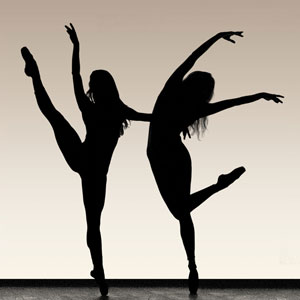Studio Connections
Reviewed by Kathi E.B. Ellis.
Entire contents are copyright © 2012 Kathi E.B. Ellis. All rights reserved.
Studio Connections may be the best kept secret of the Louisville Ballet’s programming. And this should change! Once or twice a year Bruce Simpson, the choreographers and dancers of the Ballet put together an evening of dances in their Main Street studio that span centuries and styles. This program is a great way for audiences to be introduced to a wider span of work than is possible in the main stage season and, within the confines of a studio setting, the production values are of equal value to those of the main stage season.
This fall’s Studio Connections was introduced by Artistic Director Bruce Simpson, who gave the small audience a concise and witty overview of the choreographic history that the evening would cover, skillfully drawing a line from Auguste Bournonville to today’s choreographers, placing this art in both social and political contexts, and inviting us to see the connections down the centuries. The Studio Connections program in February of this year was structured more as a “compare and contrast” across the centuries.
The first two offerings were both created by Danish choreographer Auguste Bournonville. Mr. Simpson introduced the act two excerpt of La Sylphide, reminding us that in his ten years with the company, they have danced the full version of this lissome classic only once. Based on the strength of the evening’s sylphs – drawn from the increasingly strong trainee company – it is time to consider remounting this epitome of romantic ballet. The second piece of the evening was the pas de deux from Bournonville’s Flower Festival in Genzano.
In the title role of La Sylphide, Amanda Diehl embodied the essence of both the allure and the wraith-like appeal of this spirit. Justin Michael Hogan is another strong addition to the company this season, dancing James with an assurance unshadowed by the ultimate outcome of his love for the sylphide, and the crisp footwork needed for this choreography. The leading sylph was danced by Helen Daigle, together with Leigh Anne Albrechta and Kateryna Sellars as the two other primary sylphs.
Ms. Sellars returned for the Flower Festivalpas de deux, partnered by Rob Morrow. This flirtatious and yet demure romantic encounter was a delightful contrast to La Sylphide, giving the audience an opportunity to appreciate how Bournonville’s very specific dance vocabulary travels easily between a fantasy romantic world and a more recognizable romantic relationship. Crisply costumed in blue and white, Ms. Sellars and Mr. Morrow enjoyed their romantic interlude with brio.
Company member Ben Needham-Wood’s powerful Apollo and Daphne was the next variation on the program. I originally saw this ballet during last fall’s Choreographers Showcase, and Erica De La O and Douglas Ruiz’s partnership in this intense and disturbing ballet has deepened over time. This piece could be in every compilation program, and audiences would find new nuances each time – I look forward to experiencing this piece many times with the powerful partnership between these two dancers.
Returning to a more traditional pas de deux, the evening continued with the Act III pas de deux from Sleeping Beauty, one of the most difficult sequences in the classical ballet canon. The variation was danced by Natalia Ashikhmina and Kristopher Wotjera. The exacting intricacies of the partnering, including the signature fish dives, are spell-binding in such close quarters as the studio, allowing audiences to see in much more detail how the choreography is executed. While this may add more pressure to the dancers than in the safe distance of the Whitney, the appreciation with which this piece was received was an affirmation of the precision with which these two dancers performed this variation. Placed after Apollo and Daphne, the Sleeping Beauty pas de deux also provided a fascinating juxtaposition of how partnering and lifts have developed in the past century and a half.
The middle section of the evening was rounded out by the delightful and humorous The Rainbow Connection choreographed by Rob Morrow. Again, my first introduction to this piece was last fall and, again, I’m delighted that the charm of this piece bears repeated viewings.
The final offering of the evening was Mikella Bruzina’s 2000 Harmony of Contrasts. This was my first time viewing this ballet. I enjoyed a different interpretation of Benjamin Britten’s Simple Symphony, a piece that I always associate with children’s nursery rhymes. In the close confines of the studio I found the costuming – tie-died browns for the earth ensemble and blues for sky – to be overly proscriptive (though this may not be so in a traditional theatre). On the other hand, details such as pointe shoes and loose hair for the women in the sky ensemble and ballet slippers and hair in buns for women in the earth ensemble subtly reinforced the choreographic choices for each ensemble. The piece intricately balances the differences between these elements and the ways in which they are interdependent. At one point the dancers form a diagonal tableau, alternating earth and sky down the line, repeating and sharing motifs from one end to the other – a conceit carried into the curtain call. A harmonious piece indeed, one that is both starkly different from the ensemble work seen in the first piece of the evening, and that carries on the traditions of past generations of ensemble dance variations.
These occasional programs are not only wonderful evenings of dance but an informal opportunity for local balletomanes to place their love of the dance into an artistic and historic context. We can hope that both Studio Connections and the Choreographers Showcase will long be staples of the Louisville Ballet’s programming.
October 31-November 3, 2012
Louisville Ballet Studios
315 East Main Street
Louisville, KY 40202
(502) 583-2623





